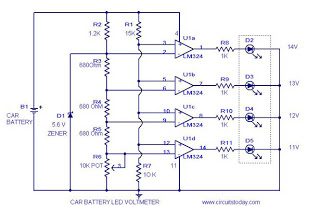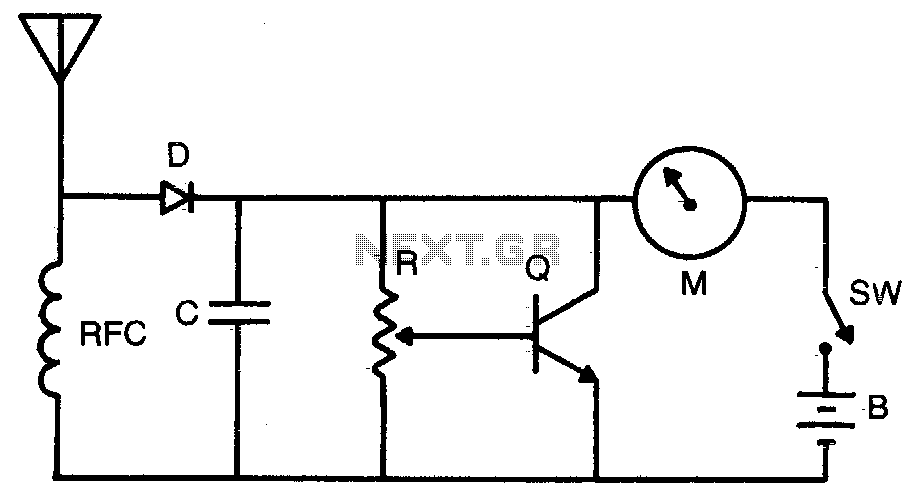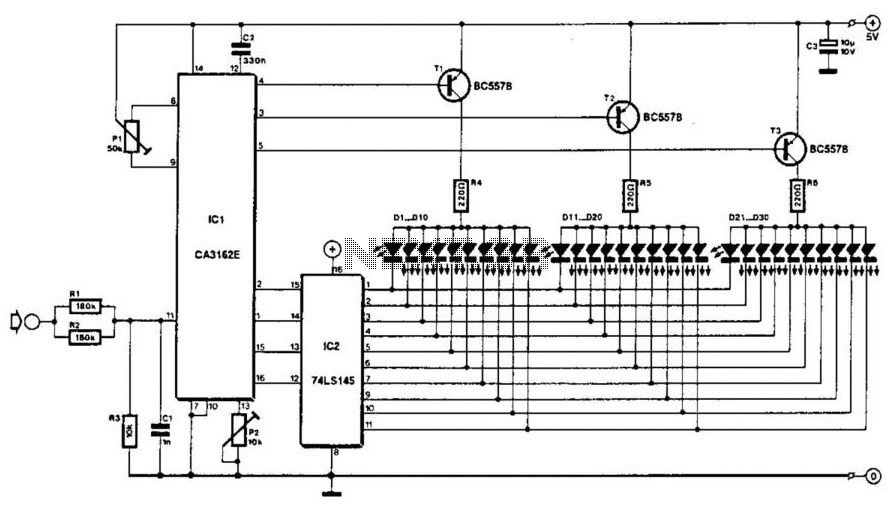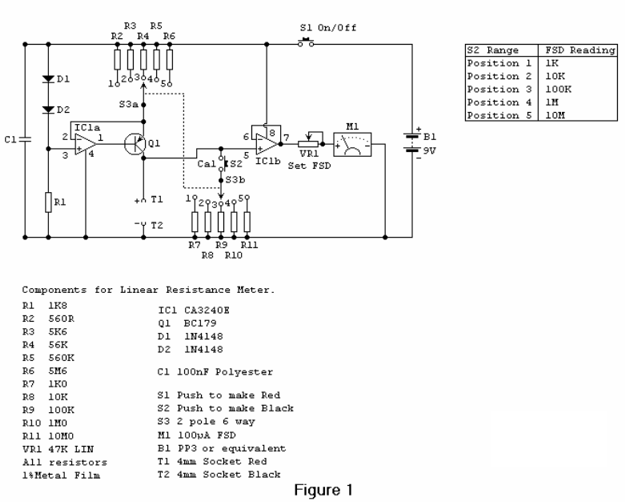
EM Field Probe with Meter
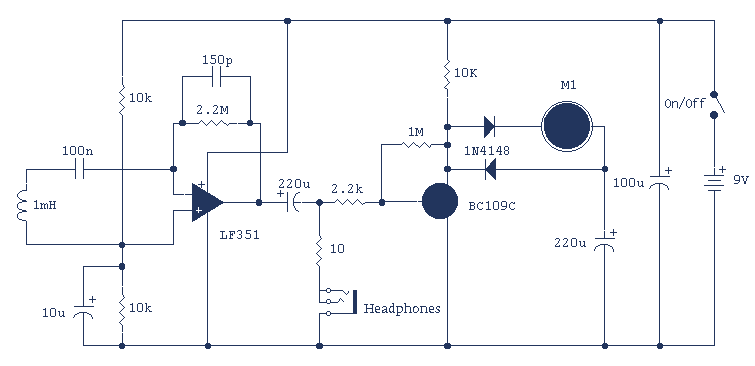
This tester is designed to locate stray electromagnetic (EM) fields. It will easily detect both audio and RF signals up to frequencies of around 100kHz. Note, however that this circuit is NOT a metal detector, but will detect metal wiring if it conducting ac current. Frequency response is from 50Hz to about 100kHz gain being rolled off by the 150p capacitor, the gain of the op-amp and input capacitance of the probe cable. Stereo headphones may be used to monitor audio frequencies at the socket, SK1. More: Meter Circuit: The output signal from the op-amp is an ac voltage at the frequency of the electro-magnetic field. This voltage is further amplified by the BC109C transistor, before being full wave rectified and fed to the meter circuit. The meter is a sm
This electromagnetic field (EMF) tester circuit is designed to accurately detect stray EM fields across a frequency range from 50 Hz to approximately 100 kHz. The circuit employs an operational amplifier (op-amp) as the primary signal processing unit, which amplifies the incoming alternating current (AC) signals generated by nearby electromagnetic sources. The op-amp's gain is influenced by the input capacitance of the probe cable, along with a 150 pF capacitor that rolls off the gain at higher frequencies, ensuring that the circuit remains sensitive to lower frequency signals while preventing distortion at the upper end of its operational range.
The output from the op-amp is an AC voltage that corresponds to the frequency of the detected electromagnetic field. This voltage is then fed into a BC109C transistor, which serves as an additional amplification stage. The transistor enhances the signal strength before it undergoes full-wave rectification. The rectification process converts the AC signal into a direct current (DC) signal, which can be easily measured and displayed.
The rectified output is directed to a meter circuit, which is responsible for providing a visual indication of the detected EM field strength. The design allows for the use of stereo headphones connected to socket SK1, enabling real-time audio monitoring of the detected frequencies. This feature is particularly useful for identifying specific sources of electromagnetic interference, as users can listen to the audio signals generated by the EM fields.
It is important to note that while this circuit is effective at detecting electromagnetic fields, it is not designed to function as a metal detector. However, it can detect metal wiring if it is carrying an AC current, due to the electromagnetic fields generated around the conductors. This capability makes the tester a valuable tool for identifying potential sources of interference in various electronic applications.This tester is designed to locate stray electromagnetic (EM) fields. It will easily detect both audio and RF signals up to frequencies of around 100kHz. Note, however that this circuit is NOT a metal detector, but will detect metal wiring if it conducting ac current. Frequency response is from 50Hz to about 100kHz gain being rolled off by the 150p capacitor, the gain of the op-amp and input capacitance of the probe cable.
Stereo headphones may be used to monitor audio frequencies at the socket, SK1. Meter Circuit: The output signal from the op-amp is an ac voltage at the frequency of the electro-magnetic field. This voltage is further amplified by the BC109C transistor, before being full wave rectified and fed to the meter circuit.
The meter is a sm 🔗 External reference
This electromagnetic field (EMF) tester circuit is designed to accurately detect stray EM fields across a frequency range from 50 Hz to approximately 100 kHz. The circuit employs an operational amplifier (op-amp) as the primary signal processing unit, which amplifies the incoming alternating current (AC) signals generated by nearby electromagnetic sources. The op-amp's gain is influenced by the input capacitance of the probe cable, along with a 150 pF capacitor that rolls off the gain at higher frequencies, ensuring that the circuit remains sensitive to lower frequency signals while preventing distortion at the upper end of its operational range.
The output from the op-amp is an AC voltage that corresponds to the frequency of the detected electromagnetic field. This voltage is then fed into a BC109C transistor, which serves as an additional amplification stage. The transistor enhances the signal strength before it undergoes full-wave rectification. The rectification process converts the AC signal into a direct current (DC) signal, which can be easily measured and displayed.
The rectified output is directed to a meter circuit, which is responsible for providing a visual indication of the detected EM field strength. The design allows for the use of stereo headphones connected to socket SK1, enabling real-time audio monitoring of the detected frequencies. This feature is particularly useful for identifying specific sources of electromagnetic interference, as users can listen to the audio signals generated by the EM fields.
It is important to note that while this circuit is effective at detecting electromagnetic fields, it is not designed to function as a metal detector. However, it can detect metal wiring if it is carrying an AC current, due to the electromagnetic fields generated around the conductors. This capability makes the tester a valuable tool for identifying potential sources of interference in various electronic applications.This tester is designed to locate stray electromagnetic (EM) fields. It will easily detect both audio and RF signals up to frequencies of around 100kHz. Note, however that this circuit is NOT a metal detector, but will detect metal wiring if it conducting ac current. Frequency response is from 50Hz to about 100kHz gain being rolled off by the 150p capacitor, the gain of the op-amp and input capacitance of the probe cable.
Stereo headphones may be used to monitor audio frequencies at the socket, SK1. Meter Circuit: The output signal from the op-amp is an ac voltage at the frequency of the electro-magnetic field. This voltage is further amplified by the BC109C transistor, before being full wave rectified and fed to the meter circuit.
The meter is a sm 🔗 External reference

